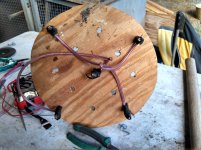joshuabardwell
Elite Member
I decided to build a stick electrode caddy out of a piece of 4" pipe that's been sitting out behind my barn since I moved in here (and probably longer). One problem: how to clean the rust out of the inside of the pipe. A wiser person would have just bought a clean piece of pipe and gone from there, but I'm not one to do something efficiently if I can do it in some cobbled-together way that involves not leaving the house or spending any (more) money. I realized that electrolytic rust removal would be perfect for this job.
In case you're not familiar, electrolytic rust removal is basically the opposite of electro-plating, at least that's how I see it. Instead of plating the surface of the metal with another metal, you cause the rust to migrate off of the metal. You can read more about the process here: ELECTROLYTIC RUST REMOVAL (ELECTROLYSIS)
Lid of the bucket, holding the rebar in place. A rebar is in the center as well, to clean the inside of the tube.

Wired up together using 12 ga speaker wire.

The whole process simmering away.

I couldn't get my battery charger to work, because it's smart and it won't charge if it doesn't detect a battery, so I hooked the whole thing up to a 12 volt battery instead. I measured the current at 2 amps, which seemed safe enough. There is no fuse, though, so if something should accidentally touch and short, the battery could be damaged, but I think that's about the worst I have to worry about.
In case you're not familiar, electrolytic rust removal is basically the opposite of electro-plating, at least that's how I see it. Instead of plating the surface of the metal with another metal, you cause the rust to migrate off of the metal. You can read more about the process here: ELECTROLYTIC RUST REMOVAL (ELECTROLYSIS)
Lid of the bucket, holding the rebar in place. A rebar is in the center as well, to clean the inside of the tube.

Wired up together using 12 ga speaker wire.

The whole process simmering away.

I couldn't get my battery charger to work, because it's smart and it won't charge if it doesn't detect a battery, so I hooked the whole thing up to a 12 volt battery instead. I measured the current at 2 amps, which seemed safe enough. There is no fuse, though, so if something should accidentally touch and short, the battery could be damaged, but I think that's about the worst I have to worry about.

